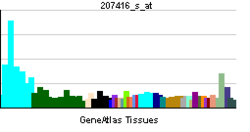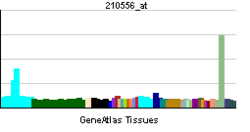- NFATC3
-
Nuclear factor of activated T-cells, cytoplasmic 3 is a protein that in humans is encoded by the NFATC3 gene.[1][2]
The product of this gene is a member of the nuclear factors of activated T cells DNA-binding transcription complex. This complex consists of at least two components: a preexisting cytosolic component that translocates to the nucleus upon T cell receptor (TCR) stimulation and an inducible nuclear component. Other members of this family participate to form this complex also. The product of this gene plays a role in the regulation of gene expression in T cells and immature thymocytes. Four transcript variants encoding distinct isoforms have been identified for this gene.[2]
Contents
See also
References
- ^ Hoey T, Sun YL, Williamson K, Xu X (Jun 1995). "Isolation of two new members of the NF-AT gene family and functional characterization of the NF-AT proteins". Immunity 2 (5): 461–72. doi:10.1016/1074-7613(95)90027-6. PMID 7749981.
- ^ a b "Entrez Gene: NFATC3 nuclear factor of activated T-cells, cytoplasmic, calcineurin-dependent 3". http://www.ncbi.nlm.nih.gov/sites/entrez?Db=gene&Cmd=ShowDetailView&TermToSearch=4775.
Further reading
- Rao A, Luo C, Hogan PG (1997). "Transcription factors of the NFAT family: regulation and function.". Annu. Rev. Immunol. 15: 707–47. doi:10.1146/annurev.immunol.15.1.707. PMID 9143705.
- Crabtree GR (1999). "Generic signals and specific outcomes: signaling through Ca2+, calcineurin, and NF-AT.". Cell 96 (5): 611–4. doi:10.1016/S0092-8674(00)80571-1. PMID 10089876.
- Horsley V, Pavlath GK (2002). "NFAT: ubiquitous regulator of cell differentiation and adaptation.". J. Cell Biol. 156 (5): 771–4. doi:10.1083/jcb.200111073. PMC 2173310. PMID 11877454. http://www.pubmedcentral.nih.gov/articlerender.fcgi?tool=pmcentrez&artid=2173310.
- Masuda ES, Naito Y, Tokumitsu H, et al. (1995). "NFATx, a novel member of the nuclear factor of activated T cells family that is expressed predominantly in the thymus.". Mol. Cell. Biol. 15 (5): 2697–706. PMC 230500. PMID 7739550. http://www.pubmedcentral.nih.gov/articlerender.fcgi?tool=pmcentrez&artid=230500.
- Jabado N, Le Deist F, Fisher A, Hivroz C (1994). "Interaction of HIV gp120 and anti-CD4 antibodies with the CD4 molecule on human CD4+ T cells inhibits the binding activity of NF-AT, NF-kappa B and AP-1, three nuclear factors regulating interleukin-2 gene enhancer activity.". Eur. J. Immunol. 24 (11): 2646–52. doi:10.1002/eji.1830241112. PMID 7957556.
- Vacca A, Farina M, Maroder M, et al. (1995). "Human immunodeficiency virus type-1 tat enhances interleukin-2 promoter activity through synergism with phorbol ester and calcium-mediated activation of the NF-AT cis-regulatory motif.". Biochem. Biophys. Res. Commun. 205 (1): 467–74. doi:10.1006/bbrc.1994.2689. PMID 7999066.
- Di Somma MM, Majolini MB, Burastero SE, et al. (1996). "Cyclosporin A sensitivity of the HIV-1 long terminal repeat identifies distinct p56lck-dependent pathways activated by CD4 triggering.". Eur. J. Immunol. 26 (9): 2181–8. doi:10.1002/eji.1830260933. PMID 8814265.
- Masuda ES, Liu J, Imamura R, et al. (1997). "Control of NFATx1 nuclear translocation by a calcineurin-regulated inhibitory domain.". Mol. Cell. Biol. 17 (4): 2066–75. PMC 232054. PMID 9121455. http://www.pubmedcentral.nih.gov/articlerender.fcgi?tool=pmcentrez&artid=232054.
- Chow CW, Rincón M, Cavanagh J, et al. (1997). "Nuclear accumulation of NFAT4 opposed by the JNK signal transduction pathway.". Science 278 (5343): 1638–41. doi:10.1126/science.278.5343.1638. PMID 9374467.
- Amasaki Y, Masuda ES, Imamura R, et al. (1998). "Distinct NFAT family proteins are involved in the nuclear NFAT-DNA binding complexes from human thymocyte subsets.". J. Immunol. 160 (5): 2324–33. PMID 9498773.
- Zhu J, Shibasaki F, Price R, et al. (1998). "Intramolecular masking of nuclear import signal on NF-AT4 by casein kinase I and MEKK1.". Cell 93 (5): 851–61. doi:10.1016/S0092-8674(00)81445-2. PMID 9630228.
- Aramburu J, Garcia-Cózar F, Raghavan A, et al. (1998). "Selective inhibition of NFAT activation by a peptide spanning the calcineurin targeting site of NFAT.". Mol. Cell 1 (5): 627–37. doi:10.1016/S1097-2765(00)80063-5. PMID 9660947.
- Imamura R, Masuda ES, Naito Y, et al. (1998). "Carboxyl-terminal 15-amino acid sequence of NFATx1 is possibly created by tissue-specific splicing and is essential for transactivation activity in T cells.". J. Immunol. 161 (7): 3455–63. PMID 9759864.
- Loftus BJ, Kim UJ, Sneddon VP, et al. (1999). "Genome duplications and other features in 12 Mb of DNA sequence from human chromosome 16p and 16q.". Genomics 60 (3): 295–308. doi:10.1006/geno.1999.5927. PMID 10493829.
- Amasaki Y, Adachi S, Ishida Y, et al. (2002). "A constitutively nuclear form of NFATx shows efficient transactivation activity and induces differentiation of CD4(+)CD8(+) T cells.". J. Biol. Chem. 277 (28): 25640–8. doi:10.1074/jbc.M201860200. PMID 11997392.
- Chagnon P, Michaud J, Mitchell G, et al. (2003). "A missense mutation (R565W) in cirhin (FLJ14728) in North American Indian childhood cirrhosis.". Am. J. Hum. Genet. 71 (6): 1443–9. doi:10.1086/344580. PMC 378590. PMID 12417987. http://www.pubmedcentral.nih.gov/articlerender.fcgi?tool=pmcentrez&artid=378590.
External links
This article incorporates text from the United States National Library of Medicine, which is in the public domain.
Transcription factors and intracellular receptors (1) Basic domains (1.1) Basic leucine zipper (bZIP)Activating transcription factor (AATF, 1, 2, 3, 4, 5, 6, 7) · AP-1 (c-Fos, FOSB, FOSL1, FOSL2, JDP2, c-Jun, JUNB, JUND) · BACH (1, 2) · BATF · BLZF1 · C/EBP (α, β, γ, δ, ε, ζ) · CREB (1, 3, L1) · CREM · DBP · DDIT3 · GABPA · HLF · MAF (B, F, G, K) · NFE (2, L1, L2, L3) · NFIL3 · NRL · NRF (1, 2, 3) · XBP1(1.2) Basic helix-loop-helix (bHLH)ATOH1 · AhR · AHRR · ARNT · ASCL1 · BHLHB2 · BMAL (ARNTL, ARNTL2) · CLOCK · EPAS1 · FIGLA · HAND (1, 2) · HES (5, 6) · HEY (1, 2, L) · HES1 · HIF (1A, 3A) · ID (1, 2, 3, 4) · LYL1 · MESP2 · MXD4 · MYCL1 · MYCN · Myogenic regulatory factors (MyoD, Myogenin, MYF5, MYF6) · Neurogenins (1, 2, 3) · NeuroD (1, 2) · NPAS (1, 2, 3) · OLIG (1, 2) · Pho4 · Scleraxis · SIM (1, 2) · TAL (1, 2) · Twist · USF1(1.3) bHLH-ZIP(1.4) NF-1(1.5) RF-X(1.6) Basic helix-span-helix (bHSH)(2) Zinc finger DNA-binding domains (2.1) Nuclear receptor (Cys4)subfamily 1 (Thyroid hormone (α, β), CAR, FXR, LXR (α, β), PPAR (α, β/δ, γ), PXR, RAR (α, β, γ), ROR (α, β, γ), Rev-ErbA (α, β), VDR)
subfamily 2 (COUP-TF (I, II), Ear-2, HNF4 (α, γ), PNR, RXR (α, β, γ), Testicular receptor (2, 4), TLX)
subfamily 3 (Steroid hormone (Androgen, Estrogen (α, β), Glucocorticoid, Mineralocorticoid, Progesterone), Estrogen related (α, β, γ))
subfamily 4 NUR (NGFIB, NOR1, NURR1) · subfamily 5 (LRH-1, SF1) · subfamily 6 (GCNF) · subfamily 0 (DAX1, SHP)(2.2) Other Cys4(2.3) Cys2His2General transcription factors (TFIIA, TFIIB, TFIID, TFIIE (1, 2), TFIIF (1, 2), TFIIH (1, 2, 4, 2I, 3A, 3C1, 3C2))
ATBF1 · BCL (6, 11A, 11B) · CTCF · E4F1 · EGR (1, 2, 3, 4) · ERV3 · GFI1 · GLI-Krüppel family (1, 2, 3, REST, S2, YY1) · HIC (1, 2) · HIVEP (1, 2, 3) · IKZF (1, 2, 3) · ILF (2, 3) · KLF (2, 3, 4, 5, 6, 7, 8, 9, 10, 11, 12, 13, 14, 15, 17) · MTF1 · MYT1 · OSR1 · PRDM9 · SALL (1, 2, 3, 4) · SP (1, 2, 4, 7, 8) · TSHZ3 · WT1 · Zbtb7 (7A, 7B) · ZBTB (16, 17, 20, 32, 33, 40) · zinc finger (3, 7, 9, 10, 19, 22, 24, 33B, 34, 35, 41, 43, 44, 51, 74, 143, 146, 148, 165, 202, 217, 219, 238, 239, 259, 267, 268, 281, 295, 300, 318, 330, 346, 350, 365, 366, 384, 423, 451, 452, 471, 593, 638, 644, 649, 655)(2.4) Cys6(2.5) Alternating composition(3) Helix-turn-helix domains (3.1) HomeodomainARX · CDX (1, 2) · CRX · CUTL1 · DBX (1, 2) · DLX (3, 4, 5) · EMX2 · EN (1, 2) · FHL (1, 2, 3) · HESX1 · HHEX · HLX · Homeobox (A1, A2, A3, A4, A5, A7, A9, A10, A11, A13, B1, B2, B3, B4, B5, B6, B7, B8, B9, B13, C4, C5, C6, C8, C9, C10, C11, C12, C13, D1, D3, D4, D8, D9, D10, D11, D12, D13) · HOPX · IRX (1, 2, 3, 4, 5, 6, MKX) · LMX (1A, 1B) · MEIS (1, 2) · MEOX2 · MNX1 · MSX (1, 2) · NANOG · NKX (2-1, 2-2, 2-3, 2-5, 3-1, 3-2, 6-1, 6-2) · NOBOX · PBX (1, 2, 3) · PHF (1, 3, 6, 8, 10, 16, 17, 20, 21A) · PHOX (2A, 2B) · PITX (1, 2, 3) · POU domain (PIT-1, BRN-3: A, B, C, Octamer transcription factor: 1, 2, 3/4, 6, 7, 11) · OTX (1, 2) · PDX1 · SATB2 · SHOX2 · VAX1 · ZEB (1, 2)(3.2) Paired box(3.3) Fork head / winged helix(3.4) Heat Shock Factors(3.5) Tryptophan clusters(3.6) TEA domain(4) β-Scaffold factors with minor groove contacts (4.1) Rel homology region(4.2) STAT(4.3) p53(4.4) MADS box(4.6) TATA binding proteins(4.7) High-mobility group(4.10) Cold-shock domainCSDA, YBX1(4.11) Runt(0) Other transcription factors (0.2) HMGI(Y)(0.3) Pocket domain(0.6) Miscellaneoussee also transcription factor/coregulator deficiencies
B bsyn: dna (repl, cycl, reco, repr) · tscr (fact, tcrg, nucl, rnat, rept, ptts) · tltn (risu, pttl, nexn) · dnab, rnab/runp · stru (domn, 1°, 2°, 3°, 4°)Categories:- Human proteins
- Transcription factors
- Chromosome 16 gene stubs
Wikimedia Foundation. 2010.



